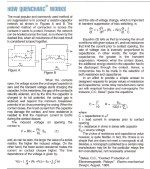Good morning!
I'm feeding on this thread (especially post #31 / #32 and wondering about the variations in the implementation...
While in the build-guide for the F4, a X rated cap is placed across the AC live and neutral, Mark Johnson seems to be in favor of a C-R network (across the switch or across AC live-neutral?)... and some explanations seem to make sense (like, no need for R if the C is small enough), I am looking for advice on how to properly, correctly install this?
Is the omission of R a compromise or just plain good (or "good enough")?
Here's the external documentations (re-uploaded, sorry, and the PDF can't be inserted):

Have a nice day!
I'm feeding on this thread (especially post #31 / #32 and wondering about the variations in the implementation...
While in the build-guide for the F4, a X rated cap is placed across the AC live and neutral, Mark Johnson seems to be in favor of a C-R network (across the switch or across AC live-neutral?)... and some explanations seem to make sense (like, no need for R if the C is small enough), I am looking for advice on how to properly, correctly install this?
Is the omission of R a compromise or just plain good (or "good enough")?
Here's the external documentations (re-uploaded, sorry, and the PDF can't be inserted):

Have a nice day!
Attachments
Commercial units:
Cornell Dubilier (CDE) QAS Arc Suppressor/Snubber Network Film Capacitors
https://www.mouser.com/new/cornell-dubilier/cde-qas-film-capacitors/
DESIGN OF SNUBBERS FOR POWER CIRCUITS
By Rudy Severns
https://rudys.typepad.com/files/cd-snubber-design.pdf
and
https://rudys.typepad.com/files/snubber-e-book-complete.pdf
Cornell Dubilier (CDE) QAS Arc Suppressor/Snubber Network Film Capacitors
https://www.mouser.com/new/cornell-dubilier/cde-qas-film-capacitors/
DESIGN OF SNUBBERS FOR POWER CIRCUITS
By Rudy Severns
https://rudys.typepad.com/files/cd-snubber-design.pdf
and
https://rudys.typepad.com/files/snubber-e-book-complete.pdf
Suppression across the mains limits the egress of perturbations. Across the load, it limits ingress + arcing, but not perfectly. Across the switch, it eliminates arcing but does nothing for ingress or egress of perturbations.
Summary: chose your evil...
Summary: chose your evil...
I prefer Figure B of the Quencharc image in post #1. In that circuit the impedance between the mains and the post-switch load, is infinity ohms; zero microamperes of current flow from the mains to the load when the switch is open circuit.
While in Figure A, even when the switch is open circuit, there will be current flow from mains to load at 50 Hertz (because the capacitor in the arc suppressor has impedance Z=1/(2*pi*fmains*C) and that Z is less than infinity at 50 Hertz).
While in Figure A, even when the switch is open circuit, there will be current flow from mains to load at 50 Hertz (because the capacitor in the arc suppressor has impedance Z=1/(2*pi*fmains*C) and that Z is less than infinity at 50 Hertz).
A snubber circuit can leak enough current to shock, best across the load, not the switch, so that switched off means switched off... Perhaps the best is snub incoming mains and outgoing load, but not across switch. However snubbing across mains costs you money when the switch is open as you get charged for that current.
Only an SSR can do it.
The issue with a mechanical switch is prelling. It opens and closes very rapidly within a few milliseconds, until fully opens (or closes). This effect can be reduced by special construction, like a fast action switch, arc extinguishing chamber (for bigger industrial switches) or a capacitor across the switch that takes up the arc energy. Arc is always created when current is quickly. interrupted, this is a fact. Wire inductance also contributes to the arc energy, this is why an RC snubber can be beneficial to dissipate the energy in the resonant LC circuit.
The issue with a mechanical switch is prelling. It opens and closes very rapidly within a few milliseconds, until fully opens (or closes). This effect can be reduced by special construction, like a fast action switch, arc extinguishing chamber (for bigger industrial switches) or a capacitor across the switch that takes up the arc energy. Arc is always created when current is quickly. interrupted, this is a fact. Wire inductance also contributes to the arc energy, this is why an RC snubber can be beneficial to dissipate the energy in the resonant LC circuit.
I read a while ago that the common C.C. Bates formula for snubbers actually does not prevent arcing across a switch (or all kinds of arcing):
https://arcsuppressiontechnologies....oster-6-The-RC-Snubber-Redesigned-2021-05.pdf
https://arcsuppressiontechnologies....oster-6-The-RC-Snubber-Redesigned-2021-05.pdf
Yes, I heard of this. When I started my DIY-adventure (F4), I sifted through the web and found a german company that makes (pretty costly) jigs for precisely this. And Mark mentioned he's making use of it, in the quasimodo or H9KPXG thread…A proper way to prevent arcing would be to turn off the switch when the load current is exactly zero amperes. At this moment, the energy stored in the load inductance (prop to I^2) would also be zero leaving no room for arcing.
It's both funny and understandable this isn't discussed here...
[edit: that's fsm.ag, german website]
and: phew!
It took me quite a while until I, uhm, "understood" figure A and B respectively... (felt that warm sensation of "aha" between my ears)
- Home
- Design & Build
- Construction Tips
- proper switch arc prevention?